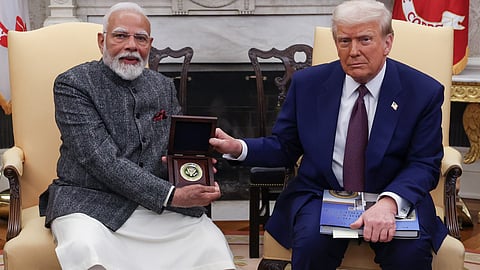

India is grappling with the impact of a 50% tariff imposed by U.S. President Donald Trump on Indian goods, effective Wednesday, targeting New Delhi’s purchase of Russian oil.
The tariffs, among the highest globally, threaten billions in trade and thousands of jobs, straining U.S.-India relations.
Until recently, the U.S. was India’s largest trading partner, with bilateral trade at $212 billion in 2024.
The Global Trade Research Initiative estimates Indian exports to the U.S. could drop from $86.5 billion to $50 billion by 2026, hitting labor-intensive sectors hardest.
Prime Minister Narendra Modi has responded with a call for self-reliance and promised tax reforms to cushion the economic blow.
Textiles, gems, jewelry, shrimp, and carpets face a projected 70% collapse in exports, endangering livelihoods in these labor-intensive industries.
“There will be a huge impact,” said MK Venu, founding editor of The Wire.
Small companies in these sectors risk losing business to competitors like Vietnam and Bangladesh.
However, pharmaceuticals, critical for U.S. healthcare, are exempt from the 50% tariff, with India supplying half of America’s generic drugs, valued at $8.7 billion in 2024.
Semiconductors, consumer electronics, steel, aluminum, and passenger vehicles fall under separate sector-specific tariffs, offering some relief to these industries.
Modi has pledged to protect farmers and bolster domestic consumption through a “massive tax bonanza.”
“We should become self-reliant – not out of desperation, but out of pride,” he said during his Independence Day speech.
His government plans to simplify the goods and services tax (GST) and has already announced a $12 billion income tax cut.
These measures, alongside salary hikes for state employees and pensioners, aim to boost spending.
An Indian commerce ministry official indicated exporters would receive financial aid to diversify into markets like Latin America and the Middle East.
However, Venu criticized the lack of clear policy, questioning how subsidies would be funded and their sufficiency against the tariff’s impact.
The tariffs stem from Trump’s objections to India’s Russian oil imports, which rose to 37% of its supply post-Ukraine war.
India’s foreign ministry called the tariffs “unfair,” noting that other nations like China face lower levies despite similar imports.
With trade talks stalled, India is exploring stronger ties with China and Russia, alongside multilateral trade pacts.
Economists estimate a 0.9-1% GDP hit, potentially lowering India’s 2026 growth forecast from 6.4%.
Modi’s push for self-reliance and tax reforms seeks to maintain economic momentum, but the tariffs challenge India’s ambitions to become a global manufacturing hub.